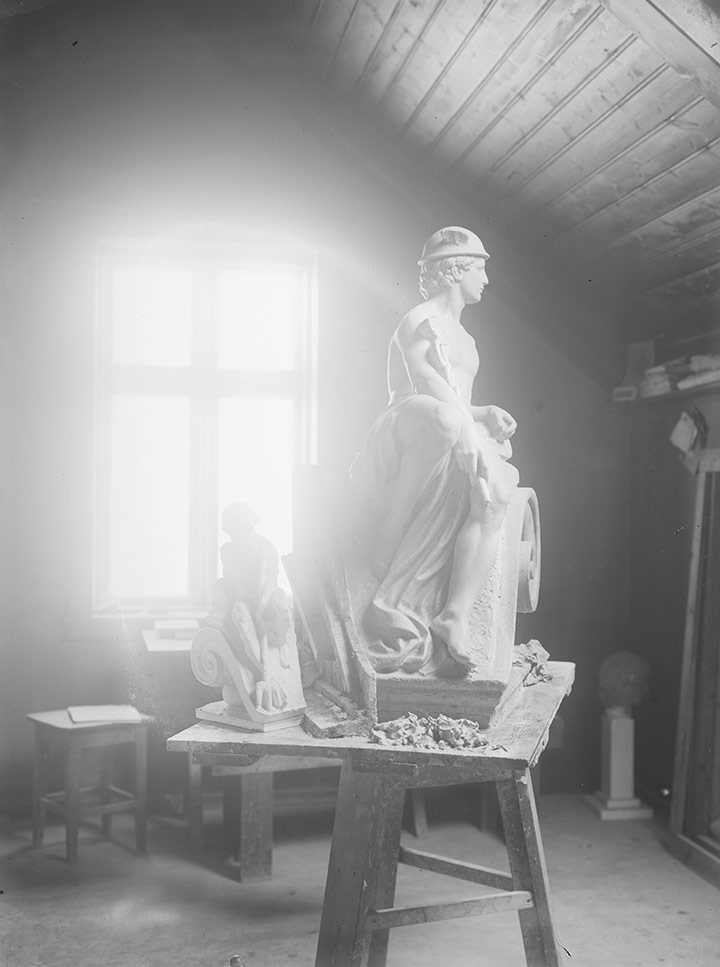
Tvedt Models | Narve Skarpmoen, Nasjonalbiblioteket | Public Domain
Technology and machines have taken a central role in Western culture, pushing aside nature in a way that a great many people find worrying. But perhaps it is only by understanding the mechanistic facet of our own nature that we can once again nurture that which is most human. Courtesy of Caja Negra Editora, we’ve published a segment of Erik Davis’s book TechGnosis. Myth, Magic, and Mysticism in the Age of Information, to be released in Spanish at the beginning of June.
If human history is the story of a creature who molts from ape to angel—or, as Nietzsche claimed, from beast to Superman—then somewhere along the way it seems that we must become machines. This destiny is rooted in our recent historical evolution. For as the engines of civilization pulled us farther and farther away from the unpredictable and often spiteful dance of nature, we withdrew from the animistic imagination that once immersed us in a living network of material forces and ruling intelligences. We started dreaming of transcending the old gods, of controlling our “animal souls,” of building an urban heaven on a mastered earth. We became moderns. Though technology was by no means the only way that humans expressed or inculcated their experience of standing apart from nature, it certainly became the Western way. The modern West could even be said to have made a pact with machines—those systematic assemblages of working parts and potentials that by definition lack a vital spirit, a soul grounded in the metaphysical order of things. And so today, now that we have technologized our environment and isolated the self within a scientific frame of mind, we no longer turn to nature to echo our state. Now we catch our reflections, even our spirits, in the movements and mentations of machines.
This imaginal relationship between man and machine was a long time coming. The ground was laid by the mechanistic cosmologists of ancient Greece, and it seized the imagination when tinkerers like Heron started building those fanciful protorobots we call automata—mechanical gods, dolls, and birds that fascinated ancient and medieval folks as much as they fascinate kids at Disneyland today. The elaborate clocks that decorated medieval churches were often outfitted with mechanical figures representing sinners, saints, grim reapers, and beasts, all mimicking our passage through time. The notion of a mechanistic cosmos, which these clocks helped engender, eventually landed us at the philosophical doorstep of Descartes, who adopted the revolutionary notion that bodies were not animated by spirits of any kind. The difference between a living being and a corpse was nothing more than the difference between a wound-up watch and a spent automata. The Catholic Church recognized the threat to religion that Descartes’s new mechanistic philosophy posed but was satisfied with the philosopher’s dualistic solution: simply divide the res cogitans, the realm of the mind, from the res extensa, the spatial world of bodies and objects, and insist that never the twain shall meet.
The enormously productive power of Cartesian philosophy ensured that bone-cold mechanism would come to dominate the Western worldview—so much so that today the flimsy wall that Descartes erected to protect the thinking subject has broken down. Cognitive scientists, psychopharmacologists, and geneticists are now off-roading into the wilderness of the human mind, mapping every step of the way. The most cherished images and experiences of the self are being colonized by authoritative scientific languages that threaten to reduce our minds and personalities to complex mechanisms—Rube Goldberg assemblages of genetic codes, mammalian habits, and bubbling vats of neurochemicals. Modern psychology can barely keep its hoary old tales alive; as Time magazine opined, even the Oedipus complex, that grand drama of human personality, has been reduced to a matter of molecules.
As we come to know more about the nuts and bolts of human life, we inevitably come to suspect that our actions, thoughts, and experiences, which seem so spontaneous and free, are programmed into our bodyminds with the mercilessness of clockwork. Speaking before the congressional committee that funded the Human Genome Project, which sequenced the entire human genetic code, the Nobel laureate James Watson said, “We used to think that our fate was in the stars. Now we know that, in large measure, our fate is in our genes.”[1] As if such genetic determinism wasn’t enough, sociologists and psychologists have also amassed a load of evidence that points to the profoundly automatic patterns of much of our social and cultural life—patterns that arise not only from our animal instincts but from institutions, family dramas, and cultural conditioning. Common sense may not be so common after all; our understanding of what constitutes normal reality may simply represent the power of what the psychologist Charles Tart calls “consensus trance.”
With the relative decline of overtly authoritarian political regimes, we now believe ourselves more “free,” but the power of consensus trance may actually be waxing in our highly networked and hypermediated age. As the hairsplitting scientific management of the Taylorist factory proved, capitalism has a long and exuberant history of embracing whatever technologies and institutional frameworks allow it to fit human beings into vast and efficient megamachines of production and consumption. The footloose “postindustrial” economy is supposed to have left such soulless mechanisms of control behind, but in reality the megamachine has simply fragmented and mutated. While handing off its primitive assembly lines to developing countries or illegal sweatshops, it “spiritualizes” its routines into immaterial cybernetic meshes of information labor or the sophisticated marketing games appropriate to a society based on compulsive consumption. Charlie Chaplin’s little tramp, enmeshed in the cogs of Modern Times, has gone virtual, becoming at once the home-shopping networker and the electronic sweatshop grunt whose every key tap and bathroom break is micromanaged down to the nanosecond.
As Marshall McLuhan noted in the early 1970s, “we are all robots when uncritically involved with our technologies.”[2] Today there are far more technologies to get involved with, far more cybernetic loops demanding that we plug in and turn on. With the continued ideological dominance of reductionist science and the sociocultural dominance of its technological spawn, the once glorious isle of humanism is melting into a silicon sea. We find ourselves trapped on a cyborg sandbank, caught between the old, smoldering campfire stories and the new networks of programming and control. As we lose our faith in free will or the coherence of personality, we glimpse androids in the bathroom mirror, their eyes black with nihilism—the meaningless void that Nietzsche pegged over a century ago as the Achilles heel of modern civilization.
Needless to say, the loss of the motive soul unnerves a lot of people. Most of the spiritual, New Age, and religious activity of the moment is committed on one level or another to either trashing or supplanting the reductionist and mechanistic imaginary. Fundamentalist Christians and Native American animists alike attack Darwin’s theory of natural selection, while acupuncturists and holistic healers rekindle the magical life force of vitalism. Archetypal psychologists try to recover the timeless images of the soul, while ecological mystics call for a “reenchantment of the earth” and a rejection of the world of malls and virtual media zones. Even liberal humanists scrabble about for values, for a “politics of meaning” that can resist the steady encroachment of technological thinking.
But can we ever turn back the clock, especially to the time before there were clocks? Perhaps the image of man as a machine holds more promise than its detractors admit, especially if the image is not allowed to totally dominate our vision. For a certain breed of contemporary seeker, in fact, the ancient goal of awakening is not served by a retreat into romanticism, religious orthodoxy, or magical incantations. Instead of denying the mechanistic or automatic aspects of human being, these seekers direct the psychospiritual quest through the image of the machine, using the mechanism, as it were, to trigger its own wake-up alarm. To paraphrase the Sufi mystic Inayat Khan: one aspect of our being is like a machine, and the other aspect is like an engineer. In this view, the first step toward waking up is to recognize how zonked out and automatic we already are; such dispassionate and reductive observations help dispel delusions, reveal genuine possibilities, and thus paradoxically enable us to cultivate some of the most deeply human aspects of being. The machine thus comes to serve as an interactive mirror, an ambiguous Other we both recognize ourselves in and measure ourselves against. This is the path of the spiritual cyborg, a path whose buzzing circuits and command overrides represent both the perils and promise of techgnosis.
[1] «The Frontiers of Medicine», Time, vol. 148, n. 14 (Autumn 1996), p. 29.
[2] Marshall McLuhan and Quentin Fiore, War and Peace in the Global Village, New York, Bantam Books, 1968.



Maximiliano Gonnet | 31 May 2023
Alguien tradujo esto, no?
Administrador | 07 June 2023
Si, el texto fue traducido por tres humanas.
Leave a comment